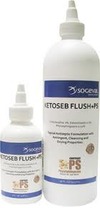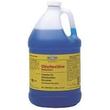Pronunciation
chlor-HEX-i-deen so-LU-shun - Pronunciation guide
Brand Names
- ChlorHex-Q Scrub
- Chlorhexidine Solution
- Dermachlor™ Flush Plus (
- Equine America® Fungasol® Spray
- Priority Care
Description
Chlorhexidine solution and chlorhexidine solution scrub have many uses in the horse stable. Chlorhexidine solution is a topical antiseptic containing 2% chlorhexidine acetate in an aqueous or detergent base. Given its wide range of activity, low systemic absorption, low systemic toxicity and a longer residual effect than other similar products, it is prescribed by veterinarians for many situations involving bacterial infections.
Usage
Chlorhexidine solution is the antiseptic of choice for many veterinarians for disinfecting the navels of foals. Chlorhexidine solution is often used as an anti-bacterial cleansng agent in the treatment and prevention of acute and chronic otitis externa, which is an ear infection often accompanied with inflammation. It is used as an oral cleansing solution in cases of gum inflammation and periodontal disease. Chlorhexidine is also used in the treatment of skin conditions, such as hot spots or acute dermatitis.
Chlorhexidine solution scrub is used to clean the perineal area and vulva of mares prior to breeding and also in obstetrical procedures.
Dosage and Administration
Administration
Rinse skin area to be treated with Chlorhexidine Solution. Wipe away excess and pat dry with a sterile gauze or sponge.
Dilution
1 oz. (2 tablespoons) of Chlorhexidine Solution per gallon of clean water.
Note
Chlorhexidine is also incorporated into a number of pre-mixed off-the-shelf product. Closely follow label directions for use of these products.
Side Effects
While generally safe and effective when prescribed by a veterinarian, chlorhexidine can cause allergic reactions, irritation, or rash in some cases.
Precautions
Chlorhexidine should always be diluted properly prior to use to avoid allergic reactions or hypersensitivity.
Chlorhexidine should never be administered without first consulting a veterinarian.
Interactions
None noted in literature.
Overdose
Overdose may produce more severe reactions than noted in side effects mentioned above.
Images
 Chlorhexidine Flush 1%
Chlorhexidine Flush 1%
 Chlorhexidine Solution 0.1%
Chlorhexidine Solution 0.1%
Literature
